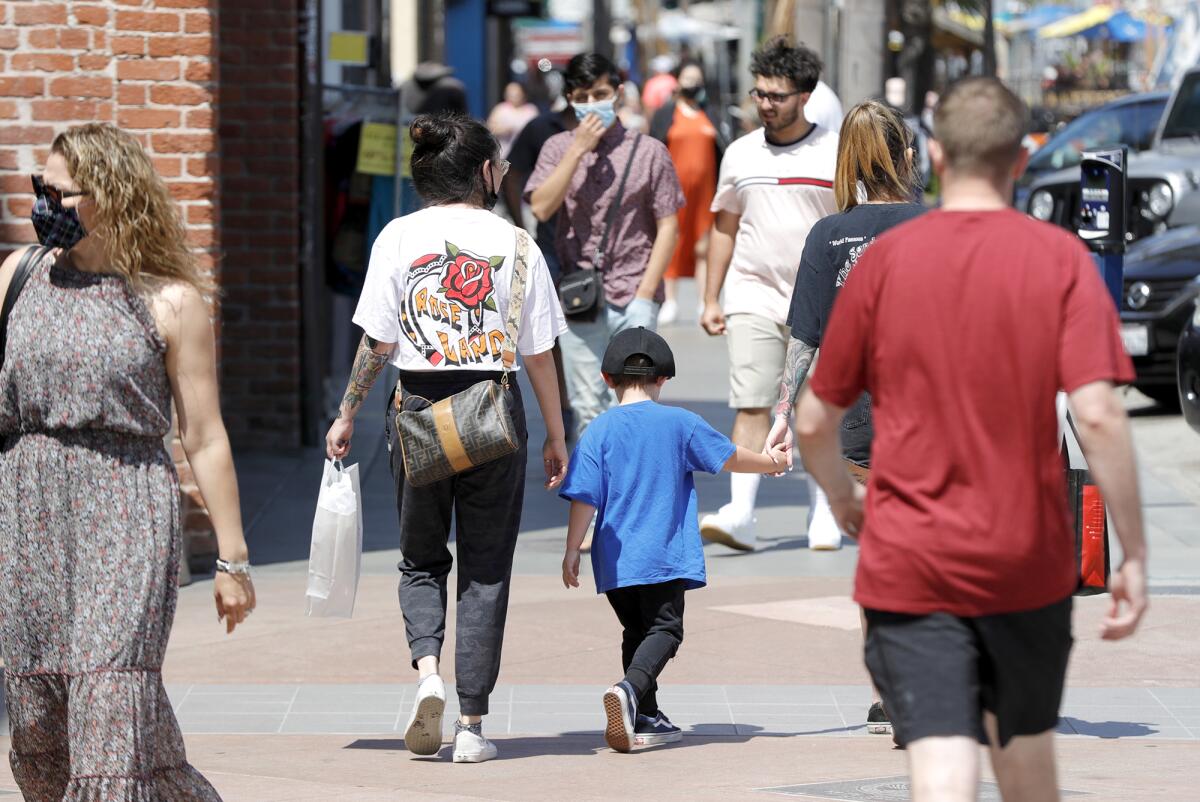O.C. health officials boast 70% vaccination among adults, but total herd immunity still elusive

- Share via
Health officials announced this week Orange County had reached “a huge milestone” in its fight against the coronavirus, as 70% of residents 18 and older had received at least one dose of the COVID-19 vaccine as of June 27.
“Vaccination has proven to be a vital component in reducing test positivity rates in our county over the last several months,” Orange County Health Care Agency Director Dr. Clayton Chau said in a release issued Wednesday. “We know the vaccines work.”
It would seem the county’s goal to achieve some level of herd immunity by July 4, an objective dubbed by incident commanders “Operation Independence,” may not be such an unthinkable mission.

But with nearly 700,000 minors countywide — 65% of whom are under 12 and, consequently, have not been approved to receive the Pfizer-BioNTech vaccine — does the current level of vaccination approach actual herd immunity?
To achieve the lowest 70% threshold of immunity among the population at large, nearly 82% of Orange County residents over age 12 would have to be vaccinated or still have sufficient levels of coronavirus antibodies in their systems after recovering from an infection.
The latter is an inscrutable number, as many forego antibodies testing. But the county still has a way to go to achieve some semblance of herd immunity.
Vaccination figures from OCHA’s online dashboard as of June 30 indicate 58.2% of all residents eligible to receive the COVID-19 vaccine have done so.
Among Orange County’s 3.22 million denizens, roughly 55.2% have been fully vaccinated. That number would climb to 62.7% if those who’ve already received the first of a two-dose regimen follow through.
Vaccination rates do increase among older populations, with residents aged 74 to 84 accounting for the most vaccinated, at 91.1%. But the rates among younger crowds are considerably lower, with 58.7% of those aged 18 to 24 having been vaccinated and 43.4% of 12- to 17-year-olds.
Andrew Noymer, a UC Irvine professor of population health and disease prevention, said he’s pleased at the progress Orange County has made so far, especially since adults face greater risk from the coronavirus than children. But, he added, that pleasure comes with some caveats.
First-dose vaccine recipients would need to get their second shots, and eligible young people would have to be vaccinated in much higher numbers to safeguard the county from the virus, particularly as more transmissible variants, like the Delta strain, begin to surface.
“Herd immunity is a moving target. It could be 70%, it could be 85%. [But] the more spreading a strain is, the higher the threshold has to be,” Noymer said. “Seventy percent may not be high enough in the presence of Delta.”
Dr. Regina Chinsio-Kwong, a deputy health officer for Orange County Health Care Agency, said Thursday officials are tracking variant cases that come into the county, adding that most new infections are occurring among the unvaccinated.
“Data currently shows that those who have been fully vaccinated are protected from serious illness and hospitalization regardless of the variant — this includes Delta,” Chinsio-Kwong wrote in an email. “If someone does get ill with a variant despite full vaccination, there is a small possibility of transmission.”
OCHA estimates that among the new coronavirus cases being identified, 90% are among residents who have not been fully vaccinated, while the unvaccinated account for 95% of the county’s current COVID-19 hospitalizations.
Noymer, an authority on epidemiology and public health and an expert on the 1918 influenza pandemic, said the COVID-19 vaccine is significantly more effective than other vaccines currently used to inoculate recipients against influenza and mumps.
“The COVID-19 vaccines kick ass. Public health has given us the best weapon against this and that is a great vaccine — now we have to use it,” Noymer said.
“Nobody likes to hear ‘keep going’ when they’re expecting congratulations,” he continued. “But I’m going to say keep going.”
All the latest on Orange County from Orange County.
Get our free TimesOC newsletter.
You may occasionally receive promotional content from the Daily Pilot.




